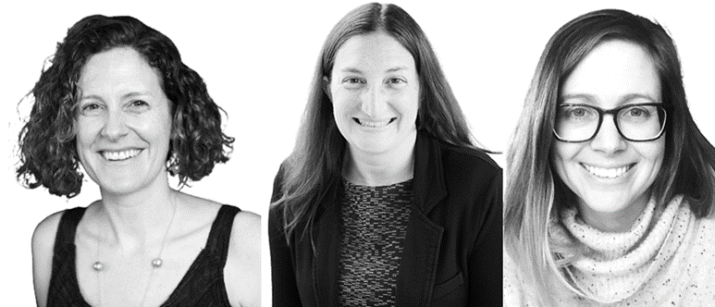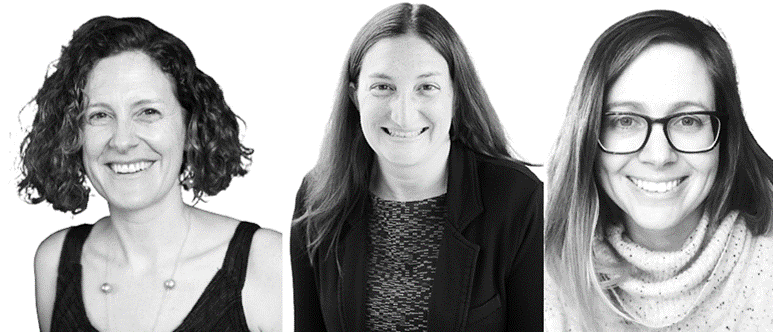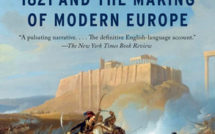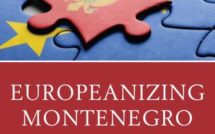
Teaching about the Holocaust in Uncertain Times: An Interview with the US Holocaust Memorial Museum

This is part of our Campus series, Teaching Genocide.
In the last several years, the disruptions due to COVID-19, the trans-Atlantic rise of the radical right, and other threats to the normative democratic order, which many of us took for granted, have forced educators to adjust, among them public educators and those who prepare instructors for difficult conversations in the classroom about past and present atrocities. EuropeNow met with three staff scholars from the United States Holocaust Memorial Museum’s (USHMM) at the Jack, Joseph and Morton Mandel Center for Advanced Holocaust studies, which has become a centerpiece for Holocaust research and education since its founding in 1993. We discussed how the institution has addressed the unique challenges posed by these uncertain times, the Mandel Center’s mission, and the many ways it has adapted to the new environment that COVID-19 has produced, as well as how the center’s work has been influenced by the rise of right-wing authoritarianism, both in the United States and across the world. Leah Wolfson, Kierra Crago-Schneider, and Katharine White spoke in one voice as “Campus Outreach,” below.
—Nicholas Ostrum for EuropeNow
EuropeNow How has the Jack, Joseph and Morton Mandel Center for Advanced Holocaust Studies moved Holocaust education on college campuses and universities forward? Are there specific ways in which you have engaged with university audiences to advance your pedagogical mission?
Campus Outreach Within the Mandel Center, the Campus Outreach Program works with faculty across North America to improve teaching, learning, and understanding of the Holocaust via the inclusion of interdisciplinary approaches to Holocaust and Holocaust-related programs and syllabi. Our team does this work by introducing faculty to Museum resources (both digital and archival), by seeding networks among faculty interested in the Holocaust, and by focusing on providing pedagogical opportunities for faculty at underserved universities. These initiatives complement the Mandel Center’s broader goal of ensuring that the field of Holocaust Studies remains vital and vibrant. This effort, in turn, supports the US Holocaust Memorial Museum’s mission to secure the permanence of Holocaust memory, understanding, and relevance and to create a world in which people are inspired to confront hatred, prevent genocide, and promote human dignity.
We engage universities in a number of ways through a broad range of programs. To start, our faculty seminar programs have been running for more than twenty years and consist of a week long winter seminar (the Jack and Anita Hess Seminar) and a two-week summer seminar (the Curt C. and Else Silberman Seminar).[1] The seminars are designed to improve understanding of and teaching about the Holocaust on college and university campuses across North America, as well as bring Holocaust studies into conversation with other disciplines and fields by connecting scholars from a range of backgrounds. To allow these exchanges to happen somewhat organically, we select advanced graduate students, early-career scholars, and more senior scholars who teach about the Holocaust through various approaches, methods, and lenses. The participants often consider this multidisciplinarity to be the most powerful part of the seminar experience. In fact, in our post-program evaluations, we find that the majority of our participants substantially change the content of their syllabi to reflect the diverse approaches and themes they encounter during the seminars, as well as the Museum resources.
The topics chosen for our seminars are intended to fulfill our goal of teaching the Holocaust from a number of angles and perspectives. For example, we recently held a two-week summer seminar on the topic of “Teaching Mass Atrocity: The Holocaust, Genocide, and Justice,” which explored postwar justice mechanisms from the Holocaust to other mass atrocities, including the Rwandan genocide, the Bosnian genocide, the case of South Sudan, and the more recent plight of the Rohingya (the Museum currently has an online and in-person exhibition on Burma’s Path to Genocide). People have reported on their experience in the seminars as being one of the best in their professional career.
EuropeNow Aside from the faculty seminar programs that you host at the United States Holocaust Museum, how do you ensure that quality teaching about the Holocaust reaches many different audiences, institutions, regions, and students?
Campus Outreach Our regional campus outreach initiative places the history of the Holocaust into conversation with local histories in North America to explore common themes across disciplines, fields, and geographic regions. We have engaged two regions so far—the Deep South and the Pacific Northwest— and have begun working with a third region where we hope to further our effort in the future: the Great Plains. In each case, we have organized panel discussions that focus on the Holocaust in relation to the historical underpinnings of topics such as the origins and symbols of neo-Nazism and white supremacy; exclusion and othering; and the struggle to memorialize persecution.
When conducting two-to-three-year initiatives within specific geographical regions, we find that students and faculty are able to make powerful connections between persecution histories that happened on either side of the Atlantic in ways that add complexity and relevance to both histories. As a professor at the University of Nebraska, Omaha, noted regarding our discussion of persecuted populations in the United States and Nazi Germany, “we made connections to help shed light on how these topics share similarities but also differences,” pointing out that “to compare is not necessarily to equate.” By collaborating with faculty from a range of institutions for these programs, we are able to further seed self-sustaining regional networks of faculty who continue to address Holocaust Studies and shared persecution histories in their research, teaching, and campus communities over the long term.
Finally, when making decisions on the universities with which to work, we always seek to reach institutions that might be referred to as underserved or under-resourced. These institutions might lack a network of scholars or faculty dedicated to advancing Holocaust studies; they might not have access to teaching tools or research materials on the Holocaust; or, in many cases, they are without resources (financial, people, or both) to sustain programs or courses on the Holocaust over the long term. By focusing on these institutions, we hope to build internal capacity for faculty to integrate Holocaust education into their existing curricula. This process oftentimes begins with providing Holocaust experts who can offer tailored lectures and workshops as part of our Campus Outreach Lecture Program.[2] The lecture program provides campus communities with an opportunity to learn about Museum resources and emerging Holocaust scholarship in ways that otherwise would be impossible.
EuropeNow When universities shut down completely due to COVID-19 in March 2020, how was your work impacted? How were you able to shift your programming to meet your academic audiences’ new needs? And what challenges did your team face throughout the pandemic?
Campus Outreach Like many other cultural and educational institutions in Washington, D.C., the Museum closed its doors to the public in March 2020, and its staff shifted to a telework model. This shift occurred at the same time as universities and primary schools were sending students home and in some cases switching almost overnight to an online educational model. We were all thrust into a new digital reality, where we were metaphorically building the plane while learning to fly it. It was a challenging moment.
One of the first things we did was reach out to and solicit feedback from our faculty and campus audiences in order to understand what they needed most at that time. Given the timeliness of these topics, many faculty decided to change the remaining sections of their Holocaust classes to include relevant discussions and materials on the topics of Nazi medical practices, the spread of disease during the Holocaust, and related public health questions. At the same time, faculty raised mental health concerns with regard to talking about the Holocaust and genocide, given the challenges that their students were facing as a result of the pandemic.
Our top priority in the early months of COVID-19 was to respond quickly and effectively to the many requests we received for Holocaust-related resources for online teaching. We wanted to make sure that despite the enormous hurdles that faculty were facing at the time, Holocaust content could still be taught. Based on survey feedback, we decided to produce a series of live webinars on topics ranging from public health during the Nazi era to how to redesign Holocaust modules for the digital space. The goal was to provide instructors with resources that could inform their teaching or that could be dropped directly into their syllabi and online course platforms. Feedback told us that USHMM’s online resources proved especially helpful given the fact that universities closed their libraries, limiting student access to books and other materials that were necessary to complete class assignments.
We also learned in the process. As we have all experienced, a single 45-minute lecture delivered on Zoom can be deadly. The data that the Museum collected confirmed “Zoom fatigue” as we observed students’ drop-off rates during the programs. Whenever possible, we began engineering our digital programs to have a conversational feel by including two scholars and incorporating ample visuals. We also prioritized recording the lectures in ways that would allow them to have a digital afterlife. Finally, we recognized that ensuring accessibility and captioning was critical for our audiences and thus central to our own mission.
EuropeNow As the pandemic progressed and the needs of your audiences changed over time, how did you adapt not only the format, but also the content of your programming to respond to the continued circumstances that faculty and students found themselves in during the 2020-2021 academic year?
Campus Outreach We used the summer of 2020 as a moment to level-set by surveying the broader Mandel Center network to determine what kinds of “evergreen” (i.e. more permanent) resources would continue to be needed and on what topics. Based on faculty feedback, we produced three, 20-minute short and digestible recorded lectures for use in the classroom that focused on introducing Holocaust resources into the classroom:
- reading Holocaust diaries,
- teaching through Holocaust photographs, and
- understanding the history of eugenics from Nazi Germany to the United States.
The lectures have averaged 20,000 views and continue to be integrated into college courses in a number of different ways.
In addition to producing new digital resources, we also redesigned our bread-and-butter programming for the new online environment in ways that generated results that both surprised and pleased us. With the transition to digital regional programming in the fall of 2020, our networking potential and reach grew enormously, as did the richness of the conversations we were able to foster. For instance, we could have experts from Washington State University, Eastern Washington University, the Tri-Cities area, and Germany all discussing the memory and memorialization of traumatic events in different contexts. We had organized these types of conversations using an in-person model in the past, of course, but we often found the reach of the in-person programs to be limited, given that they had to occur on a single campus and were thus primarily attended by students from within that campus community. The use of the digital format allowed our team to expand access points to so many different institutions, which made this programming even more effective. The greater Pacific Northwest network, which has been the target of our digital regional programming over the past two years, now includes 98 faculty who collectively represent 15 institutions from four different states and provinces in Canada.
Many of our co-organizers have expressed their desire to work collaboratively with other institutions in the area but did not know how to create such networks. The regional programming initiative allows these faculty and staff members to not only co-organize programming, but to bring the Holocaust into discussion with local and relevant persecution histories. We have learned that this has allowed for long-term impact on the campuses and in the areas where we work. This approach indeed allows for different, tailored conversations in each location, which makes Holocaust studies sustainable and applicable on campuses. Regional programming efforts to bring Holocaust into conversation with local persecution histories brings in new perspectives and points of intersection that further research and writing in all involved disciplines.
The seminars focused on how we could provide faculty with engaging and collaborative experiences using the Museum’s digital resources that are designed for the online classroom. We decided to structure them to include both asynchronous and synchronous components with the goal of using our “live time” in ways that were (and remain) geared toward offering pedagogical design approaches and relevant USHMM resources. Faculty members who participated in a recent seminar on “The Holocaust, Genocide, and Justice” and modified assignments as a result reported that their students’ work had been enhanced, as well as students’ understanding of not only genocide but also human rights, racism, and hate crimes. While we certainly miss not being in a room together, we have also learned about how digital formats can—when deployed mindfully and intentionally—increase access and equity. This finding has been especially clear during COVID-19, as families with young children, caregivers, and immuno-compromised individuals, among others, have only been able to participate safely in programs that are made available in the online format.
EuropeNow The past year has been particularly challenging for many reasons, not only because of the pandemic, but also because of the rise of white supremacy. Have you seen interest in Holocaust Studies change over the course of the last year as a result of the rise of neo-Nazi, antisemitic, and white supremacist movements? How have you adapted the topics addressed in your programming?
Campus Outreach We have seen a general uptick in interest in the types of programs that the Museum and the Mandel Center offer, as well as more specific requests for resources that address the historical underpinnings of antisemitism and white supremacy rooted in the Nazi era. We are able to draw on a range of Museum resources to respond to these requests, as well as on experts who have studied these topics for years. For example, the Museum has developed an online glossary on the “Origins of Neo-Nazi and White Supremacist Terms and Symbols” that interrogates the different images and symbols deployed by racist and antisemitic movements today.[3] We also have an extensive compilation of “Teaching Materials on Nazism and Jim Crow,” which focuses on the histories of antisemitism in Nazi Germany and racism in Jim Crow America during the 1930s.[4]
We have also seen an increase in requests for materials that address antisemitism in particular. In responding to these requests, the Museum has developed a series of resources on “Antisemitism and Denial” that are geared toward recognizing and confronting antisemitism and hatred today.[5] Our Facebook Live team has also produced a discussion with Deborah Lipstadt, the 2019-2020 Ina Levine Invitational Scholar at the Mandel Center and Professor at Emory University, on “Antisemitism Here and Now,” which continues to be widely viewed by both academic and non-academic audiences.[6] In addition, the Campus Outreach team has provided university communities and classes with tailored lectures by experts on the history of antisemitism in response to specific requests.
Fostering conversations that address these difficult topics through nuanced and historically informed discussions is exactly the type of work that we have always striven to deliver. One cannot talk about white supremacy without thinking about its historical underpinnings, some of which stem from Nazi ideology. And we cannot talk about the transnational history of eugenics without thinking about how Nazi ideology deployed it. When we talk about antisemitism and the ways in which has emerged, we first need to consider how Nazi Germany “racialized” and weaponized it.
Today, we also think about listening to the voices of the persecuted and marginalized. The history of the Holocaust was told for many years without the inclusion of Jewish voices. The assumption was that very few sources featuring the victims’ voices existed at all and that if they did, they would not significantly change our perspective on these events. Through Museum publications like Jewish Responses to Persecution and The Encyclopedia of Camps and Ghettos and digital resources like Experiencing History, we can learn about individual Jewish experiences and responses to the Holocaust.[7] Our programs and resources now also highlight victimization and persecution during this period more broadly by highlighting Roma and Sinti voices, individuals with disabilities, and those of diverse genders and sexualities, as well as Soviet prisoners-of-war, East European forced laborers, and others.
In the online lecture that we produced with Alexandra Garbarini of Williams College, she discusses how we read Holocaust diaries, noting their importance:
to anchor different histories, to anchor histories of racism and antisemitism; assimilation and marginality; exclusion and genocide. We also read them to develop modes of listening and speaking. Modes that are respectful and also self-caring: about things like trauma, memory, survival. In most diaries, it is abundantly clear that the diarists were aware of the fact that they were witnessing and experiencing history in the making. Many Jewish people’s reaction was to write it all down. What are ours?
Garbarini’s words could easily speak to any generation and all generations, including our own, especially when we consider what we do when faced with extraordinary circumstances.
Leah Wolfson, PhD, is the Rosalyn Unger Director of Campus Outreach Programs at the Jack, Joseph and Morton Mandel Center for Advanced Holocaust Studies at the USHMM. She received her PhD in Comparative Literature with an emphasis in Jewish Studies from Emory University. She is the author of Jewish Responses to Persecution, Volume V, 1944-1946 (Rowan and Littlefield, 2015).
Katharine White, PhD, is a Campus Outreach Program Officer at the Jack, Joseph and Morton Mandel Center for Advanced Holocaust Studies at the USHMM. She received her PhD in modern German history from George Washington University in 2018. She holds an MA in history from McGill University and a BA in history with an Italian minor from Boston University. Her work has recently been published in the Central European History and Humanity Journal.
Kierra Crago-Schneider, PhD is a Campus Outreach Program Officer at the Jack, Joseph and Morton Mandel Center for Advanced Holocaust Studies at the USHMM. She received her PhD in Holocaust and Post-Holocaust History from the University of California, Los Angeles in 2013. She holds two MAs in Modern European and Jewish History from the University of California, Riverside and the University of California, Los Angeles respectively. Crago-Schneider’s work has appeared in Yad Vashem Studies, Holocaust and Genocide Studies and The JDC at 100: A Century of Humanitarianism, edited by Avinoam Patt, Atina Grossmann, Linda G. Levi and Maud S. Mandel (Detroit: Wayne State University Press, 2019).
Nicholas Ostrum received his PhD in History from Stony Brook University in 2017. He is currently an instructor at Xavier University of Louisiana and has been a member of EuropeNow’s Research Editorial Committee since the journal’s inception. Since 2021, he has also served as co-chair of the Critical European Studies Research Network at CES. He has published articles, reviews, and pedagogical pieces in numerous journals, including The International History Review, The Journal of World History, and, of course, EuropeNow. He also contributed a chapter to the collected volume, After the Imperialist Imagination: 25 Years of Research on Global Germany and Its Legacies.
References
[1] Jack and Anita Hess Faculty Seminar, USHMM, https://www.ushmm.org/research/opportunities-for-academics/faculty-seminars/hess; Curt C. and Else Silberman Faculty Seminar, USHMM, https://www.ushmm.org/research/opportunities-for-academics/faculty-seminars/silberman,
[2] Campus Outreach Lecture Program, USHMM, https://www.ushmm.org/research/opportunities-for-academics/campus-outreach-programs/campus-outreach-lecture-program.
[3] Origins of Neo-Nazi and White Supremacist Terms and Symbols, USHMM, https://www.ushmm.org/antisemitism/what-is-antisemitism/origins-of-neo-nazi-and-white-supremacist-terms-and-symbols.
[4] Teaching Materials on Nazism and Jim Crow, USHMM, https://www.ushmm.org/teach/teaching-materials/nazism-and-jim-crow.
[5] Antisemitism and Holocaust Denial, USHMM, https://www.ushmm.org/antisemitism.
[6] Antisemitism: Here and Now: A Virtual Event, USHMM, https://www.ushmm.org/online-calendar/event/vefbstayconantsm0420.
[7] Geoffrey P. Megargee, ed. Encyclopedia of Camps and Ghettos, 1933-1945, Vols. 1-4 (Indianapolis, IN: Indiana University Press, various years), https://www.ushmm.org/research/publications/encyclopedia-camps-ghettos; Jürgen Matthäus and Emil Kerenji, Jewish Responses to Persecution, 1933—1946: A Source Reader (Lanham, Maryland: Rowman and Littlefield, 2017); Experiencing History: Holocaust Sources in Context, USHMM, https://perspectives.ushmm.org/.
Published on February 21, 2023.




